Even though Global Warming had triggered Climate Change, we can expect 50% of the rains. We used to get 100% rains, say 10 years ago. Even though rains are less, the V C says we will get rains and that sporadic rains will continue till November !
The Vedic Astro Calendar
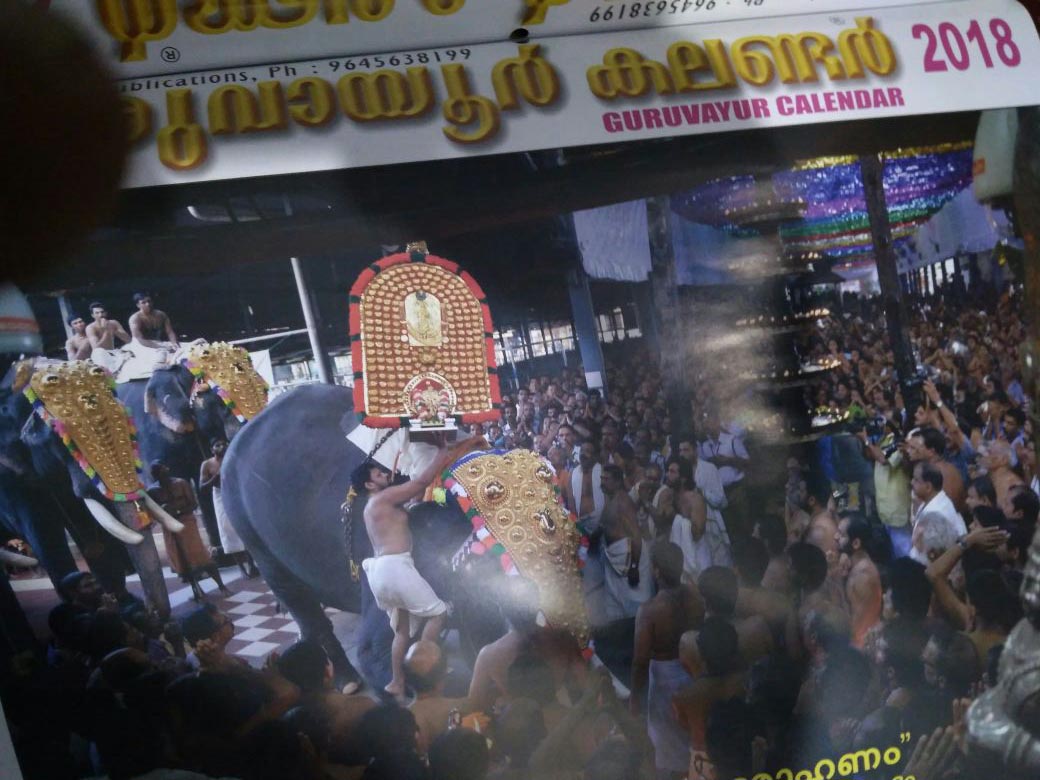
As the Sun entered the 15th degree of Taurus, Edava Pathi began in right earnest. When I woke up at 0230 AM ( 29/05/2010), it was raining cats and dogs.
The rains must have continued for one hour. It was accompanied by lightning. Let us hope that Global Warming has not triggered Climate Change to that extent and we will be receiving some rains !
Unlike the Gregorian Calendar, the Vedic Astro Calendar gives the positions of the celestial bodies. For instance, today is Edavam 15th and we know that the Sun is in the 15th degree of Taurus. Today the Calender shows Thrikketta, which means that the Moon is in the constellation of Thrikketta ( Antares ) and is in Scorpio. The Calendar gives the Jnattuvelas and the Rohini Jnattuvela started on the 25th. So we are in Edava Pathi, in the midst of Rohini Jnattuvela. Rains will be sporadic but will accelerate as Makiryam, Thiruvathira, Punartham and Pooyam Jnattuvelas take over.
The Western Calendar is based on the Tropical Zodiac ( from the First degree of Aries to the 360th degree of Pisces ) and we find that the Vernal Equinoctial Point precedes one degree every 72 years. ( This is the astro phenomenon of the Precession of the Equinoxes ) Hence in the Tropical Zodiac, the First Point of Aries moves ! The Vedic Calender is based on the Sidereal Zodiac and is counted from the First Degree of Beta Aries ( Aswini ) to the 360th degree of Zeta Piscium ( Revathi ).
As the First Point of Aries moves in the Tropical Zodiac, some adjustments should be done in the Western Calendar. Pope Gregory modified the Julian Calendar by 12 days and the present Calendar came to be known after him - the Gregorian Calendar. Seasons were changing and Western astronomers were worried. So Pope Gregory added 12 more days to the Julian Calendar ! Like, today is Oct 2nd and tomorrow is Oct 14th !
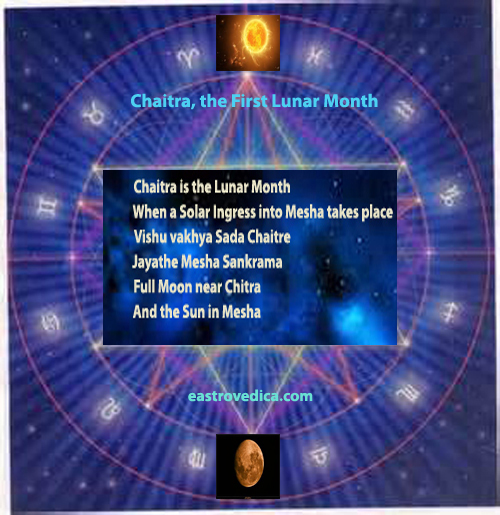
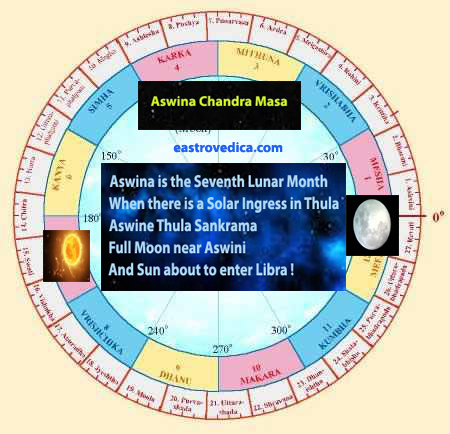
The Vedic Calendar, as it is based on the constellations of the fixed stars or rather the Sidereal Zodiac, is static and does not change. All Indian Astrology is Sidereal.
So we find that, to the man of Wisdom, the Gregorian Calendar is of no use. The Vedic gives all astro information and is informative indeed !
|
|
The Vedic Calendar was proved right again as it rained for 90 minutes here in Trichur, from 0300 AM onwards ( 31/05/2010). When I woke up at 3, it was raining cats and dogs of all descriptions.
The Vedic Calendar gives the dates of the solar months from Mesha ( Aries ) to Meena ( Pisces ). It also gives the lunations from the First Lunation ( Prathama ) to the Last Lunation ( Amavasya ). It also gives the dates for the Hindu lunar months.
|
|
The Lunar Calendar or the Luni Solar Calendar
FAQs regarding Hindu
Lunar Year ( 1939 from Mar 28 )
Q - What is Gudi Padwa?
A - It is the Hindu Lunar Year.
Q - How is it computed ?
A - The Equinoctial New Moon - when Sun conjuncts Moon near the Equinox ( Mar
21 ) - is computed.
Q - When is it this year, 2017 ?
A - On Mar 28.
The Vedic Lunar Months are lunar months based on Full Moon. The Moon comes at exactly 180 degrees from the Sun during Opposition. They are called luni solar months, because solar ingresses happen during these lunar months.
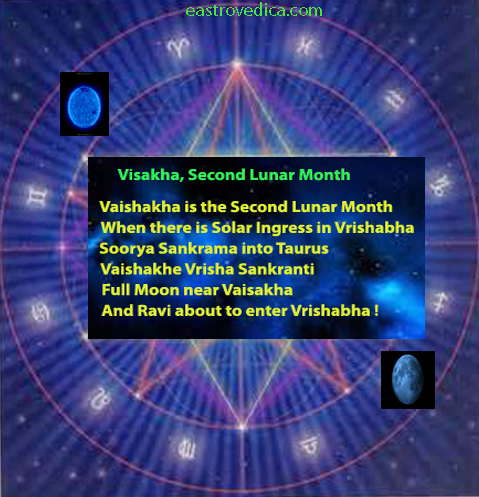
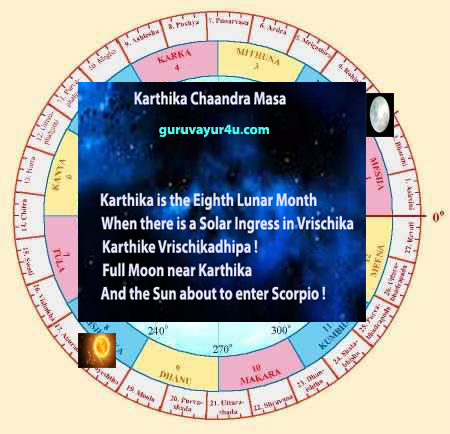
In the first month of Aries ( Mesha ) the Full Moon occurs on the constellation of Chitra and hence it is called Chaitra.
In the next month of Taurus (Vrishabha) the Full Moon occurs on the constellation of Vishakha and hence it is called Vaishakha.
In the next month of Gemini ( Mithuna) the
Full Moon occurs on the constellation of Jyeshta and hence it is
called Jyeshta.
In the next month of Cancer (Kataka ) the Full Moon occurs on the
constellation of Ashada and hence it is called Ashada.
In the next month of Leo ( Chingam ) the Full Moon occurs on the constellation of Sravana and hence it is called Sravana.
In the next month of Virgo ( Kanya ) the Full Moon occurs on the constellation of Bhadrapada and hence it is called Bhadrapada.
In the next month of Liibra ( Thula ) the Full Moon occurs on the constellation of Aswini and hence it is called Ashwin.
In the next month of Scorpio ( Vrischika ) the Full Moon occurs on the constellation of Karthika and hence it is called Karthik.
In the next month of Sagittarius ( Dhanus ) the Full Moon occurs on the constellation of Mrigasira and hence it is called Margashirsha.
In the next month of Capricorn ( Makara ) the Full Moon occurs on the constellation of Pushya and hence it is called Pusha.
In the next month of Aquarius ( Kumbha ) the Full
Moon occurs on the constellation of Makha and hence it is called Magh.
In the next month of Pisces ( Meena ) the Full Moon occurs on the
constellation of Phalguna and hence it is called Phalguna.
Vishu vakhya sada Chaitre Jayathe Mesha
Sankrama
Vaishakhe Vrisha Sankranti Jyeshte Mithuna Sankrama
Ashade Karki Sankranti Prochyate Dakshinayanam
Sravane Simha Sankranti Karthike Vrishcikadhipa
Bhadrapade Kanya Samkranti Aaswine Thula Sankrama
Margasheershe thu Dhanusha Poushe Makara Sankrama
Makara khyathu Sankranti Uttarayana Samjnitha
Maghe cha Kumbha Sankranti Phalgune Meena Sankrama
The Updated Guruvayur Calendar is here at
http://www.guruvayur4u.com/html/vedicalendar.htm